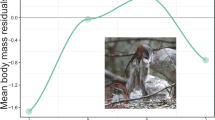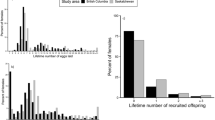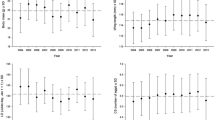Abstract
Survival is a key component of fitness. Species that occupy discrete breeding colonies with different characteristics are often exposed to varying costs and benefits associated with group size or environmental conditions, and survival is an integrative net measure of these effects. We investigated the extent to which survival probability of adult (≥1-year old) cliff swallows (Petrochelidon pyrrhonota) occupying different colonies resembled that of their parental cohort and thus whether the natal colony had long-term effects on individuals. Individuals were cross-fostered between colonies soon after hatching and their presence as breeders monitored at colonies in the western Nebraska study area for the subsequent decade. Colony-specific adult survival probabilities of offspring born and reared in the same colony, and those cross-fostered away from their natal colony soon after birth, were positively and significantly related to subsequent adult survival of the parental cohort from the natal colony. This result held when controlling for the effect of natal colony size and the age composition of the parental cohort. In contrast, colony-specific adult survival of offspring cross-fostered to a site was unrelated to that of their foster parent cohort or to the cohort of non-fostered offspring with whom they were reared. Adult survival at a colony varied inversely with fecundity, as measured by mean brood size, providing evidence for a survival–fecundity trade-off in this species. The results suggest some heritable variation in adult survival, likely maintained by negative correlations between fitness components. The study provides additional evidence that colonies represent non-random collections of individuals.



Similar content being viewed by others
References
Agrawal AA, Conner JK, Rasmann S (2010) Tradeoffs and negative correlations in evolutionary ecology. In: Bell MA, Futuyma DJ, Eanes WF, Levinton JS (eds) Evolution since Darwin: the first 150 years. Sinauer, Sunderlund, pp 243–268
Barton NH, Turelli M (1989) Evolutionary quantitative genetics: how little do we know? Annu Rev Genet 23:337–370
Bell G (2010) Fluctuating selection: the perpetual renewal of adaptation in variable environments. Phil Trans R Soc B 365:87–97
Bernardo J (1996) Maternal effects in animal ecology. Am Zool 36:83–105
Blomquist GE (2010) Heritability of individual fitness in female macaques. Evol Ecol 24:657–669
Blondel J, Pradel R, Lebreton JD (1992) Low fecundity insular blue tits do not survive better as adults than high fecundity mainland ones. J Anim Ecol 61:205–213
Brown CR (1998) Swallow summer. University of Nebraska Press, Lincoln
Brown CR, Brown MB (1986) Ectoparasitism as a cost of coloniality in cliff swallows (Hirundo pyrrhonota). Ecology 67:1206–1218
Brown CR, Brown MB (1992) Ectoparasitism as a cause of natal dispersal in cliff swallows. Ecology 73:1718–1723
Brown CR, Brown MB (1995) Cliff swallow (Hirundo pyrrhonota). In: Poole A, Gill F (eds) The birds of North America, No. 149. Academy of Natural Sciences, Philadelphia, Pennsylvania, and American Ornithologists’ Union, Washington DC
Brown CR, Brown MB (1996) Coloniality in the cliff swallow: the effect of group size on social behavior. University of Chicago Press, Chicago
Brown CR, Brown MB (1998) Intense natural selection on body size and wing and tail asymmetry in cliff swallows during severe weather. Evolution 52:1461–1475
Brown CR, Brown MB (1999) Fitness components associated with laying date in the cliff swallow. Condor 101:230–245
Brown CR, Brown MB (2000) Heritable basis for choice of group size in a colonial bird. Proc Natl Acad Sci USA 97:14825–14830
Brown CR, Brown MB (2001) Avian coloniality: progress and problems. Curr Ornithol 16:1–82
Brown CR, Brown MB (2004) Group size and ectoparasitism affect daily survival probability in a colonial bird. Behav Ecol Sociobiol 56:498–511
Brown CR, Brown MB (2014) Breeding time in a migratory songbird is predicted by drought severity and group size. Ecology 95:2736–2744
Brown CR, Brown MB (2015) Ectoparasitism shortens the breeding season in a colonial bird. R Soc Open Sci 2:140508
Brown CR, Brown MB, Rannala B (1995) Ectoparasites reduce long-term survival of their avian host. Proc R Soc Lond B 262:313–319
Brown CR, Sas CM, Brown MB (2002) Colony choice in cliff swallows: effects of heterogeneity in foraging habitat. Auk 119:446–460
Brown CR, Covas R, Anderson MD, Brown MB (2003) Multistate estimates of survival and movement in relation to colony size in the sociable weaver. Behav Ecol 14:463–471
Brown CR, Brown MB, Raouf SA, Smith LC, Wingfield JC (2005) Steroid hormone levels are related to choice of colony size in cliff swallows. Ecology 86:2904–2915
Brown CR, Brown MB, Brazeal KR (2008) Familiarity with breeding habitat improves daily survival in colonial cliff swallows. Anim Behav 76:1201–1210
Brown CR, Brown MB, Roche EA (2013a) Spatial and temporal unpredictability of colony size in cliff swallows across 30 years. Ecol Monogr 83:511–530
Brown CR, Brown MB, Roche EA (2013b) Fluctuating viability selection on morphology of cliff swallows is driven by climate. J Evol Biol 26:1129–1142
Brown CR, Roche EA, Brown MB (2014) Variation in age composition among colony sizes in cliff swallows. J Field Ornithol 85:289–300
Bryant DM (1979) Reproductive costs in the house martin (Delichon urbica). J Anim Ecol 48:655–675
Campbell DR (1997) Genetic and environmental variation in life-history traits of a monocarpic perennial: a decade-long field experiment. Evolution 51:373–382
Chambers PGS, Borralho NMG, Potts BM (1996) Genetic analysis of survival in Eucalyptus globulus spp. globulus. Silvae Genet 45:107–112
Clutton-Brock TH (ed) (1988) Reproductive success: studies of individual variation in contrasting breeding systems. University of Chicago Press, Chicago
Coltman DW, O’Donoghue P, Hogg JT, Festa-Bianchet M (2005) Selection and genetic (co)variance in bighorn sheep. Evolution 59:1372–1382
Crone EE (2001) Is survivorship a better fitness surrogate than fecundity? Evolution 55:2611–2614
De Steven D (1980) Clutch size, breeding success, and parental survival in the tree swallow (Iridoprocne bicolor). Evolution 34:278–291
Dégremont L, Bédier E, Boudry P (2010) Summer mortality of hatchery-produced Pacific oyster spat (Crassostrea gigas). II. Response to selection for survival and its influence on growth and yield. Aquaculture 299:21–29
Fry JD (2003) Detecting ecological trade-offs using selection experiments. Ecology 84:1672–1678
Fuiman LA, Cowan JH Jr (2003) Behavior and recruitment success in fish larvae: repeatability and covariation of survival skills. Ecology 84:53–67
Gustafsson L (1986) Lifetime reproductive success and heritability: empirical support for Fisher’s fundamental theorem. Am Nat 128:761–764
Hastings KK, Testa JW (1998) Maternal and birth colony effects on survival of Weddell seal offspring from McMurdo Sound, Antarctica. J Anim Ecol 67:722–740
Hoi H, Krištofík J, Darolová A (2014) All you can eat: is food supply unlimited in a colonially breeding bird? Ecol Evol. doi:10.1002/ece3.1355
Hoogland JL (1981) The evolution of coloniality in white-tailed and black-tailed prairie dogs (Sciuridae: Cynomys leucurus and C. ludovicianus). Ecology 62:252–272
Hoogland JL, Sherman PW (1976) Advantages and disadvantages of bank swallow (Riparia riparia) coloniality. Ecol Monogr 46:33–58
Kelly C, Price TD (2005) Correcting for regression to the mean in behavior and ecology. Am Nat 166:700–707
Kenway M, Macbeth M, Salmon M, McPhee C, Benzie J, Wilson K, Knibb W (2006) Heritability and genetic correlations of growth and survival in black tiger prawn Penaeus monodon reared in tanks. Aquaculture 259:138–145
Kern TD, Boutin S, LaMontagne JM, McAdam AG, Humphries MM (2007) Persistent maternal effects on juvenile survival in North American red squirrels. Biol Lett 3:289–291
Laake JL (2013) RMark: an R interface for analysis of capture-recapture data with MARK. AFSC Rep 2013-01, Alaska Fisheries Science Center, Seattle
Lindström J (1999) Early development and fitness in birds and mammals. Trends Ecol Evol 14:343–348
Loison A, Gaillard JM, Jullien JM (1996) Demographic patterns after an epizootic of keratoconjunctivitis in a chamois population. J Wildl Manage 60:517–527
Loye JE, Carroll SP (1991) Nest ectoparasite abundance and cliff swallow colony site selection, nestling development, and departure time. In: Loye JE, Zuk M (eds) Bird-parasite interactions: ecology, evolution and behavior. Oxford University Press, Oxford, pp 222–242
Merilä J, Sheldon BC (1999) Genetic architecture of fitness and nonfitness traits: empirical patterns and development of ideas. Heredity 83:103–109
Mousseau TA, Fox CW (1998) The adaptive significance of maternal effects. Trends Ecol Evol 13:403–407
Mousseau TA, Roff DA (1987) Natural selection and the heritability of fitness components. Heredity 59:181–197
Murphy MT, Armbrecth B, Vlamis E, Pierce A (2000) Is reproduction by tree swallows cost free? Auk 117:902–912
Newton I (ed) (1989) Lifetime reproduction in birds. Academic Press, London
Papaïx J, Cubaynes S, Buoro M, Charmantier A, Perret P, Gimenez O (2010) Combining capture–recapture data and pedigree information to assess heritability of demographic parameters in the wild. J Evol Biol 23:2176–2184
Pfister CA (1998) Patterns of variance in stage-structured populations: evolutionary predictions and ecological implications. Proc Natl Acad Sci USA 95:213–218
Post E, Stenseth NC, Langvatn R, Fromentin JM (1997) Global climate change and phenotypic variation among red deer cohorts. Proc R Soc Lond B 264:1317–1324
Price T, Schluter D (1991) On the low heritability of life-history traits. Evolution 45:853–861
R Core Team (2014) R: a language and environment for statistical computing. R Foundation for Statistical Computing, Vienna, Austria. http://www.R-project.org/
Räsänen K, Kruuk LEB (2007) Maternal effects and evolution at ecological time-scales. Funct Ecol 21:408–421
Reed WL, Clark ME, Vleck CM (2009) Maternal effects increase within-family variation in offspring survival. Am Nat 174:685–695
Robinson SK (1985) Coloniality in the yellow-rumped cacique as a defense against nest predators. Auk 102:506–519
Roche EA, Brown CR, Brown MB (2011) Heritable choice of colony size in cliff swallows: does experience trump genetics in older birds? Anim Behav 82:1275–1285
Roche EA, Brown CR, Brown MB, Lear KM (2013) Recapture heterogeneity in cliff swallows: increased exposure to mist nets leads to net avoidance. PLoS One 8:e58092
Roff DA (1992) The evolution of life histories: theory and analysis. Chapman and Hall, New York
Rose KE, Clutton-Brock TH, Guinness FE (1998) Cohort variation in male survival and lifetime breeding success in red deer. J Anim Ecol 67:979–986
SAS Institute (2004) SAS/STAT 9.1 user’s guide, version 8.2. SAS Institute, Cary, North Carolina
Serrano D, Oro D, Ursua E, Tella JL (2005) Colony size selection determines adult survival and dispersal preferences: Allee effects in a colonial bird. Am Nat 166:E22–E31
Siegel-Causey D, Kharitonov SP (1990) The evolution of coloniality. Curr Ornithol 7:285–330
Siepielski AM, DiBattista JD, Carlson SM (2009) It’s about time: the temporal dynamics of phenotypic selection in the wild. Ecol Lett 12:1261–1276
Smith JNM (1981) Does high fecundity reduce survival in song sparrows? Evolution 35:1142–1148
Snapp BD (1976) Colonial breeding in the barn swallow (Hirundo rustica) and its adaptive significance. Condor 78:471–480
Spencer KA, Verhulst S (2007) Delayed behavioral effects of postnatal exposure to corticosterone in the zebra finch (Taeniopygia guttata). Horm Behav 51:273–280
Spottiswoode CN (2007) Phenotypic sorting in morphology and reproductive investment among sociable weaver colonies. Oecologia 154:589–600
Spottiswoode CN (2009) Fine-scale life-history variation in sociable weavers in relation to colony size. J Anim Ecol 78:504–512
Stearns SC (1992) The evolution of life histories. Oxford University Press, Oxford
Tarwater CE, Beissinger SR (2013) Opposing selection and environmental variation modify optimal timing of breeding. Proc Natl Acad Sci USA 110:15365–15370
Vehviläinen H, Kause A, Quinton C, Koskinen H, Paananen T (2008) Survival of the currently fittest: genetics of rainbow trout survival across time and space. Genetics 180:507–516
Waser PM, Jones WT (1991) Survival and reproductive effort in banner-tailed kangaroo rats. Ecology 72:771–777
Wiklund CG, Andersson M (1994) Natural selection of colony size in a passerine bird. J Anim Ecol 63:765–774
Wittenberger JF, Hunt GL Jr (1985) The adaptive significance of coloniality in birds. In: Farner DS, King JR (eds) Avian biology, vol 8. Academic Press, San Diego, pp 1–78
Acknowledgments
We thank the 37 research assistants who have helped with field work since 1997 and especially Cheryl Ormston and Gabriela Redwine for their assistance with the cross-fostering study. Amy Moore and Catherine Page maintained the mark-recapture database. The School of Biological Sciences at the University of Nebraska-Lincoln allowed use of the Cedar Point Biological Station. The Clary, Knight, and Soper families and the Union Pacific Railroad granted permission to access land. Aaron Pearse and two anonymous reviewers provided useful comments on the manuscript. Financial support was provided by the National Science Foundation (DEB-9613638, DEB-0075199, IBN-9974733, DEB-0514824, DEB-1019423) and the National Institutes of Health (AI057569). Any use of trade, firm, or product names is for descriptive purposes only and does not imply endorsement by the U. S. Government.
Conflict of interest
The authors declare that they have no conflicts of interest.
Author information
Authors and Affiliations
Corresponding author
Rights and permissions
About this article
Cite this article
Brown, C.R., Roche, E.A. & Brown, M.B. Parent–offspring resemblance in colony-specific adult survival of cliff swallows. Evol Ecol 29, 537–550 (2015). https://doi.org/10.1007/s10682-015-9764-9
Received:
Accepted:
Published:
Issue Date:
DOI: https://doi.org/10.1007/s10682-015-9764-9




